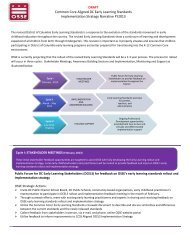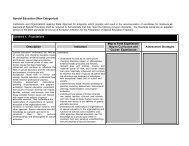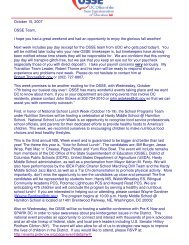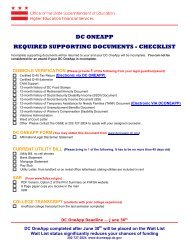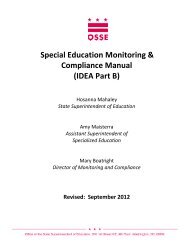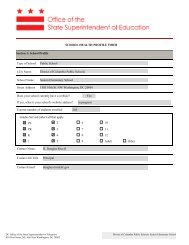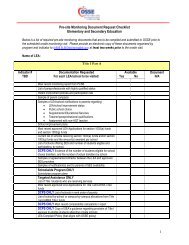DC Teacher Principal Evaluation Rubric - osse
DC Teacher Principal Evaluation Rubric - osse
DC Teacher Principal Evaluation Rubric - osse
Create successful ePaper yourself
Turn your PDF publications into a flip-book with our unique Google optimized e-Paper software.
<strong>Teacher</strong> and <strong>Principal</strong> <strong>Evaluation</strong> and Support<br />
System Requirements<br />
October 2012<br />
Purpose: The ESEA Flexibility Waiver requires that all LEAs subject to the Elementary and Secondary<br />
Education Act of 1965 (ESEA) as amended by No Child Left Behind implement teacher and leader<br />
evaluation systems that meet specific requirements outlined by the U.S. Department of Education.<br />
These state guidelines embody the requirements of the ESEA Flexibility Waiver. Non-charter LEAs,<br />
including the District of Columbia Public Schools (<strong>DC</strong>PS) will have to meet these guidelines.<br />
Pursuant to a determination of the Charter Schools Program (CSP) Director at the U.S. Department of<br />
Education dated February 3, 2012, the Public Charter School Board (PCSB) is in compliance with<br />
assurances 3A and 3B of CSP. This means that the District is considered to have a strong charter school<br />
authorizer system. OSSE will, therefore, allow District public charter schools the flexibility to develop<br />
and implement evaluation and support systems that meet all of the elements of Principle 3 of the ESEA<br />
Flexibility Waiver, but that do not necessarily adhere to these OSSE-developed guidelines.<br />
The <strong>DC</strong> OSSE will provide support to LEAs in developing appropriate growth measures and Student<br />
Learning Objectives (SLOs) if they choose to use them for teachers in non-tested grades and subjects.<br />
The <strong>DC</strong> OSSE will develop guidelines during the 2012-2013 school year for Student Learning Objectives<br />
that LEAs can use if they intend to develop SLOs. The <strong>DC</strong> OSSE will also provide professional<br />
development and technical assistance to LEAs in developing and implementing SLOs and other growth<br />
measures into their evaluation systems.<br />
Process: Non-charter LEAs will submit their unique evaluation documents that demonstrate how they<br />
meet each of these criteria. If their documents do not address all of these criteria, they will provide a<br />
brief, supplementary word document that addresses all of the criteria. For approval, the plan must meet<br />
the required elements of each section, achieving a label of “sufficient” or “meets criteria” for all. If not<br />
approved, the LEA must submit revisions based on the feedback provided. Charter LEAs will<br />
demonstrate to the PCSB that they meet the requirements of the U.S. Department of Education.<br />
Due Date: The evaluation documents are due by April 30, 2013 and should be submitted to<br />
robin.chait@dc.gov.<br />
Page 1 of 26
<strong>Teacher</strong> and Leader <strong>Evaluation</strong> System Requirements<br />
The following requirements apply to both teacher and leader evaluation systems:<br />
1. Involve teachers and principals in developing or revising evaluation systems. The LEA will<br />
describe their process for involving teachers and principals in developing or revising evaluation<br />
systems.<br />
2. Ensure validity of systems. The LEA will provide data to OSSE sufficient to allow OSSE to conduct<br />
a validity analysis or provide results to OSSE from a validity study that analyzes the correlation<br />
between observation scores and student growth or achievement measures.<br />
3. Provide training to teachers, evaluators and other school staff on the evaluation system. The<br />
LEA will describe their process for providing training to teachers, evaluators, and other school<br />
staff on the evaluation system. The LEA will describe how they work to ensure inter-rater<br />
reliability among evaluators.<br />
Page 2 of 26
Section 1 – Involve teachers and principals in developing or revising evaluation systems.<br />
The LEA will describe its process for involving teachers and principals in developing or revising<br />
evaluation systems.<br />
SUFFICIENT LIMITED 1 NOT PROVIDED<br />
The LEA has described a vague<br />
or incomplete process for<br />
involving teachers and principals<br />
in developing or revising<br />
evaluation systems.<br />
The LEA has described a<br />
thorough process for involving<br />
teachers and principals in<br />
developing or revising<br />
evaluation systems.<br />
The LEA has not described a<br />
process for involving teachers<br />
and principals in developing or<br />
revising evaluation systems.<br />
Label:<br />
Section 1 Comments/Feedback:<br />
1 If the LEA achieves a rating of Limited or Does Not Meet Criteria, the plan will not be approved and LEA staff will<br />
need to address the comments and revise the response.<br />
Page 3 of 26
Section 2 – Ensure the validity of the evaluation system.<br />
The LEA will provide data to OSSE so OSSE can conduct a validity analysis or provide results to OSSE from<br />
a validity study that analyzes the correlation between observation scores and student growth or<br />
achievement measures.<br />
( ) I agree to provide the data necessary to OSSE to conduct an analysis of the correlation between<br />
observation scores and student growth or achievement or will provide the data from this analysis.<br />
Page 4 of 26
Section 3 – Provide training to teachers, evaluators and other school staff on the evaluation system.<br />
The LEA will describe its process for providing training to teachers, evaluators, and other school staff on<br />
the evaluation system. The LEA will describe how it works to ensure inter-rater reliability among<br />
evaluators.<br />
SUFFICIENT LIMITED 2 NOT PROVIDED<br />
The LEA has described a vague<br />
or incomplete process for<br />
providing training to teachers,<br />
evaluators, and other school<br />
staff on the evaluation system,<br />
or has not described how they<br />
will work to ensure inter-rater<br />
reliability among evaluators.<br />
The LEA has described a<br />
thorough process for providing<br />
training to teachers, evaluators,<br />
and other school staff on the<br />
evaluation system, including a<br />
description of how they will<br />
work to ensure inter-rater<br />
reliability among evaluators.<br />
The LEA has not described a<br />
process for providing training to<br />
teachers, evaluators, and other<br />
school staff on the evaluation<br />
system, including a description<br />
of how they will work to ensure<br />
inter-rater reliability among<br />
evaluators.<br />
Label:<br />
Section 3 Comments/Feedback:<br />
2 If the LEA achieves a rating of Limited or Does Not Meet Criteria, the plan will not be approved and LEA staff will<br />
need to address the comments and revise the response.<br />
Page 5 of 26
<strong>Teacher</strong> <strong>Evaluation</strong> System Requirements<br />
1. Include student growth as a significant portion of teacher evaluation<br />
a. Student growth and achievement counts for 50% of a teacher’s evaluation in tested<br />
grades and subjects. The LEA will report on the components of their evaluation system<br />
and the percentages assigned to each component using the <strong>Teacher</strong> <strong>Evaluation</strong><br />
Template. The LEA should indicate that a <strong>DC</strong> CAS-based measure of growth will account<br />
for at least 30% of the evaluation rating for English/ Language Arts and mathematics<br />
teachers in grades 4-8 and may choose another assessment or measure to account for<br />
the remaining percentage.<br />
b. Student growth counts for at least 15% of a teacher’s evaluation in non-tested grades<br />
and subjects. The LEA will report on the components of their evaluation system and the<br />
percentages assigned to each component using the <strong>Teacher</strong> <strong>Evaluation</strong> Template. The<br />
LEA should describe the measure or measures that will be included in evaluations of<br />
teachers in non-tested grades and subjects and should indicate that these measures will<br />
account for at least 15% of a teacher’s evaluation. The LEA may choose from the<br />
following options for student growth measures for teachers in non-tested grades and<br />
subjects:<br />
i. Use a measure of schoolwide growth that is based on the <strong>DC</strong> CAS in<br />
English/Language Arts and/or Mathematics. (The LEA may also include<br />
schoolwide growth results based on science and composition assessments when<br />
they are available);<br />
ii. Develop student learning objectives for every classroom that are aligned with<br />
Common Core State Standards (CCSS) where available or <strong>DC</strong> or Industry<br />
Standards where CCSS are not available. In grades or subjects in which pre-tests<br />
are not available, educators will use all available prior assessments to set<br />
appropriate objectives; or<br />
iii. Develop a growth measure that is based on a standardized assessment that is<br />
aligned with or relevant to CCSS.<br />
2. Conduct an annual evaluation process. The LEA will reference its unique evaluation documents<br />
that indicate that it has an annual evaluation process for every teacher and will make available<br />
evidence that evaluations have occurred during the monitoring process.<br />
3. Use evaluations to support individualized professional development. The LEA will provide<br />
evidence that it has a system to provide individualized professional development to teachers<br />
based on identified needs. The LEA must include evidence that also references how the teacher<br />
evaluation and support system will enable special education, English Language Learner and<br />
general classroom teachers serving these student populations to improve instructional practice.<br />
The LEA may reference an evaluation document that includes an area for next steps or action<br />
items to address teachers’ areas of weakness, documentation of verbal feedback and next steps<br />
or action items, an individual professional development plan template, or an aggregate<br />
professional development plan for the school that is informed by the individual needs of<br />
teachers. The LEA may offer other evidence that demonstrates that evaluations are informing<br />
professional development.<br />
Page 6 of 26
4. Use evaluations to inform personnel decisions. The LEA provide a narrative explanation that<br />
demonstrates that evaluation information informs personnel decisions such as those about<br />
compensation, promotion, retention, and/or removal. The LEA will explain the process by which<br />
it makes these decisions and how it uses evaluation information to do so.<br />
a. The annual evaluation must include student growth and achievement as a significant<br />
portion of teacher evaluations. Because the <strong>DC</strong> CAS-based measures will be available in<br />
the summer, the LEA has flexibility in demonstrating how it is using the complete<br />
evaluation to inform human capital decisions. For example, the LEA may indicate that it<br />
is providing both preliminary decisions about hiring in the spring and final evaluation<br />
reports in the summer. Or the LEA may demonstrate that it is using both current and<br />
prior year evaluations (including prior evaluations that include student growth) to<br />
inform human capital decisions. However, the LEA will have to demonstrate that the<br />
annual evaluation is used to inform human capital decisions.<br />
b. The LEA will provide data to OSSE on the numbers of teachers in each rating category,<br />
and the number of teachers retained and dismissed in each rating category.<br />
5. Include multiple measures for performance besides the growth measure. The LEA will report<br />
on the components of its evaluation systems and the percentages assigned to each component<br />
using the <strong>Teacher</strong> <strong>Evaluation</strong> Template. The components include an observation rubric that<br />
measures more than one area of performance. Other measures of performance may be included<br />
as well. <strong>Evaluation</strong> systems may address the following areas of performance:<br />
a. Commitment to school community, mission and values. Includes professional norms<br />
and expectations, collaboration with other school staff, character, commitment to the<br />
school community, parent engagement.<br />
b. Effective lesson planning and instructional delivery. Includes planning, instructional<br />
practices, assessment, and use of data.<br />
c. Fostering a positive environment for student learning. Includes classroom<br />
management, student/teacher interactions, and student engagement.<br />
6. Divide effectiveness into at least four tiers. The LEA will provide narratives for each tier that<br />
describe the full spectrum of performance. Each narrative will describe the competencies and<br />
skills a teacher at each level is expected to master. The LEA will also describe how the tiers are<br />
determined. The LEA will report teacher effectiveness ratings to OSSE in four categories.<br />
7. Provide teachers with timely and constructive feedback. The LEA will provide evidence of an<br />
evaluation process that includes multiple observations and regular feedback. The feedback will<br />
reference the language of the LEA’s observation rubric. Evidence of timely and constructive<br />
feedback may reference evaluation documents that describe multiple formal and/or informal<br />
observations and a post-observation feedback process or another process for providing written<br />
or verbal feedback. Other evidence of timely and constructive feedback may be included, as<br />
long as it demonstrates that teachers are receiving specific feedback throughout the school<br />
year.<br />
Page 7 of 26
Instructions: Please complete the template below indicating the components of your evaluation system. Columns B-E should be completed with the submission<br />
of the teacher evaluation plan and should indicate the component of the evaluation system and the weight it represents (for example, observation rubric, 30%).<br />
One year after implementation, the LEA should provide individual teacher evaluating ratings and the total score each teacher received. If the LEA is not<br />
conducting its own validity analysis, the LEA should also submit individual component scores for each evaluation component.<br />
<strong>Teacher</strong><br />
ID<br />
1234<br />
1235<br />
1236<br />
1237<br />
1238<br />
<strong>Teacher</strong><br />
ID<br />
1239<br />
1240<br />
1241<br />
<strong>Teacher</strong><br />
Grade<br />
and<br />
Subject<br />
<strong>Teacher</strong><br />
Grade<br />
and<br />
Subject<br />
(at least<br />
30%)<br />
A<br />
<strong>DC</strong> CAS<br />
Measure<br />
<strong>Teacher</strong> <strong>Evaluation</strong> Template<br />
<strong>Teacher</strong>s in Tested Grades and Subjects<br />
<strong>Evaluation</strong> Components<br />
Final Final<br />
(at least<br />
Score <strong>Evaluation</strong><br />
15%) % % %<br />
Rating (e.g.<br />
B<br />
C D E<br />
highly<br />
Other<br />
effective,<br />
Student<br />
effective)<br />
Achievement<br />
<strong>Teacher</strong>s in Untested Grades and Subjects<br />
<strong>Evaluation</strong> Components<br />
Final Final<br />
(at least<br />
Score <strong>Evaluation</strong><br />
15%) % % % %<br />
Rating(e.g.<br />
A<br />
B C D E<br />
highly<br />
Student<br />
effective,<br />
Growth<br />
effective)<br />
Date of<br />
Final<br />
<strong>Evaluation</strong><br />
Date of<br />
Final<br />
<strong>Evaluation</strong><br />
School's Action<br />
(retained,<br />
dismissed)<br />
School's Action<br />
(retained,<br />
dismissed)<br />
Page 8 of 26
<strong>Teacher</strong> <strong>Evaluation</strong> Plan <strong>Rubric</strong><br />
Section 1- Include student growth as a significant portion of teacher evaluation.<br />
Student growth and achievement counts for 50% of a teacher’s evaluation in tested<br />
grades and subjects. The LEA will report on the components of their evaluation systems and<br />
the percentages assigned to each component using the <strong>Teacher</strong> <strong>Evaluation</strong> Template. The<br />
LEA should indicate that a <strong>DC</strong> CAS based measure of growth will account for at least 30% of<br />
the evaluation rating for English/ Language Arts and mathematics teachers in grades 4-8 and<br />
may choose another assessment or measure to account for the remaining percentage.<br />
a. Student growth counts for at least 15% of a teacher’s evaluation in non-tested grades and<br />
subjects. The LEA will report on the components of their evaluation systems and the<br />
percentages assigned to each component using the <strong>Teacher</strong> <strong>Evaluation</strong> Template. The LEA<br />
should describe the measure or measures that will be included in evaluations of teachers in<br />
non-tested grades and subjects and should indicate that these measures will account for at<br />
least 15% of a teacher’s evaluation. The LEA may choose from the following options for<br />
student growth measures for teachers in non-tested grades and subjects:<br />
i. Use a measure of schoolwide growth that is based on the <strong>DC</strong> CAS in<br />
English/Language Arts and/or Mathematics. (The LEA may also include schoolwide<br />
growth results based on science and composition assessments when they are<br />
available);<br />
ii. Develop student learning objectives for every classroom that are aligned with<br />
Common Core State Standards (CCSS) where available or <strong>DC</strong> or Industry Standards<br />
where CCSS are not available. In grades or subjects in which pre-tests are not<br />
available, educators will use all available prior assessments to set appropriate<br />
objectives; or<br />
iii. Develop a growth measure that is based on a standardized assessment that is<br />
aligned with or relevant to CCSS.<br />
a.<br />
Page 9 of 26
Section 1- Include student growth as a significant portion of teacher evaluation.<br />
MEETS CRITERIA<br />
The evaluation template indicates that student growth<br />
and achievement counts for at least 50% for tested<br />
grades and subjects and student growth or<br />
achievement counts for at least 15% for non-tested<br />
grades and subjects.<br />
DOES NOT MEET CRITERIA<br />
The evaluation template is not complete or does not<br />
indicate that student growth counts for at least 50%<br />
for tested grades and subjects and at least 15% for<br />
non-tested grades and subjects.<br />
Label:<br />
Section 1 Comments/Feedback:<br />
Page 10 of 26
Section 2 – Conduct an annual evaluation process.<br />
The LEA will reference its unique evaluation documents that indicate that the LEA has an annual<br />
evaluation process for every teacher and will make available evidence that evaluations have occurred<br />
during the monitoring process.<br />
MEETS CRITERIA<br />
A narrative description indicates the LEA conducts an<br />
annual evaluation process for every teacher and<br />
describes the process and benchmarks for this process.<br />
DOES NOT MEET CRITERIA<br />
A narrative description does not indicate that the LEA<br />
conducts an annual evaluation process for every<br />
teacher or does not describe the process and<br />
benchmarks.<br />
Label:<br />
Section 2 Comments/Feedback:<br />
Page 11 of 26
Section 3 – Use evaluations to support individualized professional development.<br />
The LEA will provide a narrative explanation that demonstrates that evaluation information informs<br />
professional development. Include information in the narrative that speaks to how the teacher<br />
evaluation and support system will enable special education, English Language Learner and general<br />
classroom teachers serving these student populations to improve instructional practice. The LEA may<br />
reference an evaluation document that includes an area for next steps or action items to address<br />
teachers’ areas of weakness, documentation of verbal feedback and next steps or action items, an<br />
individual professional development plan template, or an aggregate professional development plan for<br />
the school that is informed by the individual needs of teachers. An LEA may offer other evidence that<br />
demonstrates that evaluations are informing professional development.<br />
SUFFICIENT LIMITED 3 NOT PROVIDED<br />
The narrative explanation is<br />
provided, but it provides<br />
incomplete or vague evidence that<br />
evaluation information informs<br />
professional development.<br />
A narrative explanation references<br />
an evaluation document that<br />
includes an area for next steps or<br />
action items to address teachers’<br />
areas of weakness, documentation<br />
of verbal feedback and next steps or<br />
action items, an individual<br />
professional development plan<br />
template, an aggregate professional<br />
development plan for the school<br />
that is informed by the individual<br />
needs of teachers, or other<br />
evidence that demonstrates that<br />
evaluations are informing<br />
professional development.<br />
No explanation is provided or the<br />
explanation does not demonstrate a<br />
connection between evaluation<br />
results and professional<br />
development plans.<br />
Label:<br />
3 If an LEA achieves a rating of Limited or Not Provided, the plan will not be approved and LEA staff will need to<br />
address the comments and revise the response.<br />
Page 12 of 26
Section 3 Comments/Feedback:<br />
Page 13 of 26
Section 4 – Use evaluations to inform human capital decisions.<br />
The LEA provide a narrative explanation that demonstrates that evaluation information informs<br />
personnel decisions such as those about compensation, promotion, retention, and/or removal. The LEA<br />
will explain the process by which it makes these decisions and how it uses evaluation information to do<br />
so.<br />
a. The annual evaluation must include student growth as a significant portion of teacher<br />
evaluations. Because the <strong>DC</strong> CAS-based measures will be available in the summer, the<br />
LEA has flexibility in demonstrating how it is using the complete evaluation to inform<br />
human capital decisions. For example, the LEA may indicate that it is providing both<br />
preliminary decisions about hiring in the spring and final evaluation reports in the<br />
summer. Or the LEA may demonstrate that it is using both current and prior year<br />
evaluations (including prior evaluations that include student growth) to inform human<br />
capital decisions. However, the LEA will have to demonstrate that the annual evaluation<br />
is used to inform human capital decisions.<br />
b. The LEA will provide data to OSSE on the numbers of teachers in each rating category,<br />
and the number of teachers retained and dismissed in each rating category.<br />
SUFFICIENT LIMITED 4 NOT PROVIDED<br />
There is very little evidence that<br />
teacher evaluation results inform<br />
human capital decisions.<br />
There is clear evidence that teacher<br />
evaluation results inform human<br />
capital decisions.<br />
There is no evidence that teacher<br />
evaluation results inform human<br />
capital decisions.<br />
Section 4 Comments/Feedback:<br />
Label:<br />
4 If an LEA achieves a rating of Limited or Does Not Meet Criteria, the plan will not be approved and LEA staff will<br />
need to address the comments and revise the response.<br />
Page 14 of 26
Section 5 – Include multiple measures for performance besides the growth measure.<br />
The LEA will report on the components of its evaluation systems and the percentages assigned to each<br />
component using the <strong>Teacher</strong> <strong>Evaluation</strong> Template. The components include an observation rubric that<br />
measures more than one area of performance. Other measures of performance may be included as well.<br />
<strong>Evaluation</strong> systems may address the following areas of performance:<br />
a. Commitment to school community, mission and values. Includes professional norms and<br />
expectations, collaboration with other school staff, character, commitment to the school<br />
community, parent engagement.<br />
b. Effective lesson planning and instructional delivery. Includes planning, instructional practices,<br />
assessment, and use of data.<br />
c. Fostering a positive environment for student learning. Includes classroom management,<br />
student/teacher interactions, and student engagement.<br />
MEETS CRITERIA<br />
The evaluation system includes an observation rubric<br />
that addresses more than one area of practice.<br />
DOES NOT MEET CRITERIA<br />
The evaluation system does not include an observation<br />
rubric that addresses more than one area of practice.<br />
Label:<br />
Section 5 Comments/Feedback:<br />
Page 15 of 26
Section 6 – Divide effectiveness into at least four tiers.<br />
The LEA will provide narratives for each tier that describe the full spectrum of performance. The<br />
narrative will describe the competencies and skills a teacher at each level is expected to master. The LEA<br />
will also describe how the tiers are determined. The LEA will report teacher effectiveness ratings to OSSE<br />
in four categories.<br />
<br />
<br />
<br />
<br />
Highly effective teachers consistently achieve high scores on all elements of an LEA’s evaluation<br />
system;<br />
Effective teachers are proficient on almost all elements of a school’s evaluation system;<br />
Minimally effective teachers are those who need additional support in several of the elements<br />
of a school’s evaluation system; and<br />
Ineffective teachers are those who are struggling in most of the elements of a school’s<br />
evaluation system.<br />
SUFFICIENT LIMITED 5 NOT PROVIDED<br />
The definitions of the four tiers of<br />
performance are vague, do not<br />
describe a full spectrum of<br />
performance, or are incomplete.<br />
The definitions of four tiers of<br />
performance describe the full<br />
spectrum of performance and are<br />
very clearly described.<br />
The LEA does not have definitions for<br />
each tier.<br />
Label:<br />
Section 6 Comments/Feedback:<br />
5 If an LEA achieves a rating of Limited or Does Not Meet Criteria, the plan will not be approved and LEA staff will<br />
need to address the comments and revise the response.<br />
Page 16 of 26
Section 7 –Provide teachers with timely and constructive feedback.<br />
The LEA will provide evidence of an evaluation process that includes multiple observations and regular<br />
feedback. The feedback will reference the language of the LEA’s observation rubric. Evidence of timely<br />
and constructive feedback may reference evaluation documents that describe multiple formal and/or<br />
informal observations and a post-observation feedback process or another process for providing written<br />
or verbal feedback. Other evidence of timely and constructive feedback may be included, as long as it<br />
demonstrates that teachers are receiving specific feedback throughout the school year.<br />
SUFFICIENT LIMITED 6 NOT PROVIDED<br />
The LEA demonstrates it is giving<br />
teachers timely and constructive<br />
feedback once during the school<br />
year.<br />
The LEA demonstrates it is giving<br />
teachers timely and constructive<br />
feedback at several points<br />
throughout the school year.<br />
The LEA did not provide evidence<br />
that it is giving teachers timely and<br />
constructive feedback.<br />
Section 7 Comments/Feedback:<br />
Label:<br />
6 If an LEA achieves a rating of Limited or Does Not Meet Criteria, the plan will not be approved and LEA staff will<br />
need to address the comments and revise the response.<br />
Page 17 of 26
<strong>Principal</strong> <strong>Evaluation</strong> System Requirements<br />
1. Include student growth as a significant portion of principal evaluation. The LEA will report on<br />
the components of its evaluation system using the <strong>Principal</strong> <strong>Evaluation</strong> Template. The LEA will<br />
demonstrate that student growth accounts for a significant proportion of a principal’s<br />
evaluation rating. The LEA will explain how its student growth measure is consistent with its<br />
schools’ missions, values, and goals.<br />
2. Conduct an annual evaluation process. The LEA will reference its unique evaluation documents<br />
that indicate that the LEA has an annual evaluation process for every principal and during the<br />
monitoring process will make available evidence that evaluations have occurred.<br />
3. Use evaluations to inform human capital decisions. The LEA will explain how evaluation<br />
information will inform human capital decisions such as decisions about principals’ professional<br />
development, compensation, promotion, retention, and/or removal. For example, an LEA might<br />
indicate that principals who are highly effective will be considered for a bonus and those who<br />
are rated ineffective will be coached by a mentor. During the monitoring process, OSSE will<br />
question a significant disconnect between principal ratings over time and these decisions, for<br />
example, if many principals rated ineffective are retained.<br />
4. Include multiple, qualitative measures of performance. The LEA will report on the components<br />
of its evaluation systems using the <strong>Principal</strong> <strong>Evaluation</strong> Template. The components must include<br />
more than one qualitative measure. <strong>Evaluation</strong> systems may include the following qualitative<br />
measures of performance:<br />
a. Parent, staff, and/or student surveys<br />
b. Compliance with state or federal regulations<br />
c. Compliance with special education requirements<br />
d. <strong>Principal</strong> leadership and competencies<br />
e. Measures of teacher practice<br />
5. Include school-specific goals. The LEA will include more than one, measurable, school-specific<br />
goal. These goals may also be based on the system’s student growth measure. For example, if an<br />
LEA includes <strong>DC</strong> CAS scores as its student growth measure and gives principals a score of 1-4<br />
based on growth, they may also have a <strong>DC</strong> CAS school-specific goal to increase student growth<br />
by 10%. Following are examples of school-specific goals:<br />
a. Student performance will increase by 5% on the <strong>DC</strong> CAS.<br />
b. Parent participation in the school survey will increase by 20%.<br />
c. The achievement gap will close by at least 3 points.<br />
d. Graduation rates will increase by 10%.<br />
e. Attendance rates will average 95%.<br />
f. Detentions will decrease by 10%.<br />
6. Divide effectiveness into at least four tiers. The LEA will provide narrative descriptions for each<br />
tier that describe the full spectrum of performance and outline the competencies and skills a<br />
principal at each level is expected to master. The LEA will report to OSSE on principal<br />
performance according to four categories. After a year of implementation the LEA will complete<br />
Page 18 of 26
the <strong>Principal</strong> <strong>Evaluation</strong> Template, indicating how individual principals are rated. The LEA should<br />
consider the following general guidance in their ratings:<br />
<br />
<br />
<br />
<br />
Highly effective principals consistently achieve high scores on all elements of an LEA’s<br />
evaluation system;<br />
Effective principals are proficient on almost all elements of a school’s evaluation system;<br />
Minimally effective principals are those who need additional support in several of the<br />
elements of a school’s evaluation system; and<br />
Ineffective principals are those who are struggling in most of the elements of a school’s<br />
evaluation system.<br />
Page 19 of 26
Instructions: Please complete the template below indicating the components of your evaluation system.<br />
Columns A-E should indicate the component of the evaluation system (for example, leadership rubric,<br />
student achievement). These columns should be completed with the submission of the principal<br />
evaluation plan. The Final <strong>Evaluation</strong> Rating column should indicate the rating each principal received.<br />
<strong>Principal</strong><br />
ID<br />
<strong>Evaluation</strong> Components<br />
A B C D E<br />
Final<br />
<strong>Evaluation</strong><br />
Rating<br />
(e.g.<br />
Highly<br />
effective,<br />
effective)<br />
Date of<br />
Final<br />
<strong>Evaluation</strong><br />
Rating<br />
School's<br />
Action<br />
(retained,<br />
dismissed)<br />
1234<br />
1235<br />
1236<br />
1237<br />
1238<br />
Page 20 of 26
Section 1- Include student growth as a significant portion of principal evaluation. The LEA will report<br />
on the components of its evaluation system using the <strong>Principal</strong> <strong>Evaluation</strong> Template. The LEA will<br />
demonstrate that student growth accounts for a significant proportion of a principal’s evaluation rating.<br />
The LEA will explain how its student growth measure is consistent with its schools’ missions, values, and<br />
goals.<br />
SUFFICIENT LIMITED 7 DOES NOT MEET CRITERIA<br />
The LEA provides a clear and robust<br />
explanation of how its student<br />
growth measure is consistent with<br />
its school mission, values, and<br />
goals.<br />
The LEA provides an incomplete or<br />
vague explanation of how its<br />
student growth measure is<br />
consistent with its school mission,<br />
values, and goals.<br />
The LEA does not provide an<br />
explanation of how its student<br />
growth measure is consistent with<br />
its school mission, values, and<br />
goals.<br />
Label:<br />
Section 1 Comments/Feedback:<br />
7 If an LEA achieves a rating of Limited or Does Not Meet Criteria, the plan will not be approved and LEA staff will<br />
need to address the comments and revise the response.<br />
Page 21 of 26
Section 2 – Conduct an annual evaluation process.<br />
The LEA will reference its unique evaluation documents that indicate that the LEA has an annual<br />
evaluation process for every principal and during the monitoring process will make available evidence<br />
that evaluations have occurred.<br />
MEETS CRITERIA<br />
A narrative description indicates the LEA conducts an<br />
annual evaluation process for every principal and<br />
describes the process and benchmarks for this process.<br />
DOES NOT MEET CRITERIA<br />
A narrative description does not indicate that the LEA<br />
conducts an annual evaluation process for every<br />
principal or does not describe the process and<br />
benchmarks.<br />
Label:<br />
Section 2 Comments/Feedback:<br />
Page 22 of 26
Section 3 - Use evaluations to inform human capital decisions.<br />
The LEA will explain how evaluation information will inform human capital decisions about principals<br />
such as decisions about professional development, compensation, promotion, retention, and/or<br />
removal. For example, an LEA might indicate that principals who are highly effective will be considered<br />
for a bonus and those who are rated ineffective will be coached by a mentor. During the monitoring<br />
process, OSSE will question a significant disconnect between principal ratings over time and these<br />
decisions, for example, if many principals rated “1” are retained.<br />
SUFFICIENT LIMITED 8 NOT PROVIDED<br />
There is very little evidence that<br />
principal evaluation results inform<br />
human capital decisions.<br />
There is clear evidence that<br />
principal evaluation results inform<br />
human capital decisions.<br />
There is no evidence that principal<br />
evaluation results inform human<br />
capital decisions.<br />
Section 3 Comments/Feedback:<br />
Label:<br />
8 If an LEA achieves a rating of Limited or Does Not Meet Criteria, the plan will not be approved and LEA staff will<br />
need to address the comments and revise the response.<br />
Page 23 of 26
Section 4 – Include multiple, qualitative measures of performance.<br />
The LEA will report on the components of its evaluation systems using the <strong>Principal</strong> <strong>Evaluation</strong><br />
Template. The components must include more than one qualitative measure. <strong>Evaluation</strong> systems may<br />
include the following qualitative measures of performance:<br />
a. Parent, staff, and/or student surveys<br />
b. Compliance with state or federal regulations<br />
c. Compliance with special education requirements<br />
d. <strong>Principal</strong> leadership and competencies<br />
e. Measures of teacher practice<br />
MEETS CRITERIA<br />
The evaluation system includes more than one<br />
qualitative measure.<br />
DOES NOT MEET CRITERIA<br />
The evaluation system includes one or no qualitative<br />
measures.<br />
Label:<br />
Section 4 Comments/Feedback:<br />
Page 24 of 26
Section 5 – Include school-specific goals.<br />
The LEA will include more than one, measurable, school-specific goal. These goals may also be based on<br />
the system’s student growth measure. For example, if an LEA includes <strong>DC</strong> CAS scores as its student<br />
growth measure and gives principals a score of 1-4 based on growth, they may also have a <strong>DC</strong> CAS<br />
school-specific goal to increase student growth by 10%. Following are examples of school-specific goals:<br />
a. Student performance will increase by 5% on the <strong>DC</strong> CAS.<br />
b. Parent participation in the school survey will increase by 20%.<br />
c. The achievement gap will close by at least 3 points.<br />
d. Graduation rates will increase by 10%.<br />
e. Attendance rates will average 95%.<br />
f. Detentions will decrease by 10%.<br />
MEETS CRITERIA<br />
The evaluation system includes more than one<br />
measureable, school- specific goal.<br />
DOES NOT MEET CRITERIA<br />
The evaluation system includes one or no<br />
measureable, school-specific goals.<br />
Label:<br />
Section 5 Comments/Feedback:<br />
Page 25 of 26
Section 6 – Divide effectiveness into at least four tiers.<br />
The LEA will provide narrative descriptions for each tier that describe the full spectrum of performance<br />
and outline the competencies and skills a principal at each level is expected to master. The LEA will<br />
report to OSSE on principal performance according to four categories. After a year of implementation<br />
the LEA will complete the <strong>Principal</strong> <strong>Evaluation</strong> Template, indicating how individual principals are rated.<br />
The LEA should consider the following general guidance in their ratings:<br />
<br />
<br />
<br />
<br />
highly effective principals consistently achieve high scores on all elements of an LEA’s evaluation<br />
system;<br />
effective principals are proficient on almost all elements of a school’s evaluation system;<br />
minimally effective principals are those who need additional support in several of the elements<br />
of a school’s evaluation system; and<br />
ineffective principals are those who are struggling in most of the elements of a school’s<br />
evaluation system.<br />
SUFFICIENT LIMITED 9 NOT PROVIDED<br />
The definitions of the four tiers of<br />
performance are vague or<br />
incomplete.<br />
Four tiers of performance are very<br />
clearly defined.<br />
The LEA does not have definitions for<br />
each tier.<br />
Label:<br />
Section 6 Comments/Feedback:<br />
9 If an LEA achieves a rating of Limited or Does Not Meet Criteria, LEA staff will need to address the comments and<br />
revise the response.<br />
Page 26 of 26



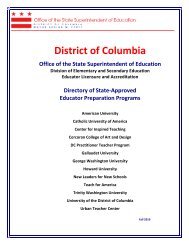



![DC Special Education Memorandum [PDF] - osse](https://img.yumpu.com/26875015/1/190x245/dc-special-education-memorandum-pdf-osse.jpg?quality=85)

